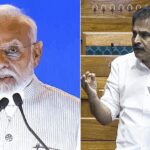Unlock the Editor’s Digest for free
Roula Khalaf, Editor of the FT, selects her favourite stories in this weekly newsletter.
After a dramatic sell-off, relative calm has returned to global financial markets — for now at least. Behind the jitters are investors who are questioning whether the American economy will achieve a long-expected “soft-landing” (where inflation returns to target without a significant slowdown). That assumption had helped push the S&P 500 to a record high by mid-July. Weak jobs data and the US Federal Reserve’s decision to hold interest rates at their peak last week stoked doubts.
Stepping back, the US is not in a recession nor is one necessarily imminent. Initial fears that the rout in financial markets could slow the real economy via a self-reinforcing downward spiral of selling have been averted as traders have started buying again. The weaker-than-expected US employment data for July, released on Friday, is also no immediate cause for alarm. The jobless rate has risen 0.6 percentage points since January, but part of the pick-up has been driven by more people entering the workforce.
Still, the American economy is cooler than markets and the Fed had perhaps appreciated. Indeed, the weak employment numbers should focus minds on the broader slowing under way in America. Take US consumers. Recent estimates suggest that excess savings from the pandemic — which helped prop up spending — have run dry. Annual spending is now growing faster than income, which is not sustainable. As it is, the credit card delinquency rate has surpassed pre-2020 levels. And while households are spending strongly, the bulk of it appears to be on non-discretionary items including high rents, utilities, and healthcare.

Next, a slew of forward-looking indicators point to an easing in economic momentum. An index of new orders in the manufacturing sector has been in contractionary territory since April. Weekly initial jobless claims, a timelier measure of stress in the labour market, have been trending upward and last week hit their highest in almost a year. Small businesses, which tend to feel the pinch of high rates first, have also been slashing their hiring plans. They employ just under 50 per cent of the US workforce.
The past few weeks of market convulsions are a reminder for investors and policymakers of the need to scrutinise a wider array of economic data points. Pollyanna-ish narratives about the economy can be blinding. Political uncertainty — including a close presidential race — and data issues have not helped the forecasting process either. For instance, jobs growth has been flagging according to the Household Survey, but is rising steadily on the non-farm payroll indicator.

The Fed and investors have been waiting all year for signs that higher interest rates are squeezing the economy. The signals are getting clearer. The problem is that economies do not slow in a linear fashion. Redundancies, bankruptcies, and foreclosures nudge up, and then tend to spiral. The impact of higher rates comes with a lag, but when it shows up, distress can rise quickly.
Further data on American jobs, inflation and economic activity is due before the Fed next meets in September. That may trigger more repricing — upwards or downwards. Either way, the Fed should avoid any emergency intervention that could ignite more panic. A rate cut at its next meeting, however, looks necessary, or the central bank risks over-restricting demand. A 50 basis point cut should also remain an option.
It is reassuring that the Fed is in a position to focus more on the other side of its dual mandate; to support employment. Price pressures are easing, and annual PCE inflation in June fell to within half a percentage point of the 2 per cent target. Economic growth is not falling off a cliff, but signs of a slowdown are clear. The soft landing remains in place, but the runway is shorter than many had thought.





